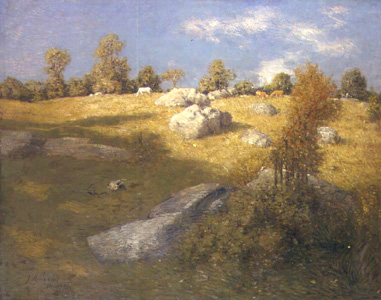Weir << weer >> Farm National Historical Park, in Wilton, Connecticut, was the summer home and studio of J. Alden Weir, an American Impressionist painter of the late 1800’s and early 1900’s. Impressionism is a style of art begun by French painters that presents an immediate impression of an object or event. In 1882, Weir exchanged a still-life painting for the house and farm. He retreated from his New York City studio and home to the tranquillity of the farm. The landscape inspired him and other prominent American artists. The historical park tells the story of Weir’s role in American art and the ongoing artistic legacy of the farm.
The park includes the art studios of Weir and his son-in-law, artist Mahonri M. Young. Young, who married Weir’s daughter Dorothy, was a grandson of the Mormon leader Brigham Young. Also in the park are the original home, outbuildings, and barns of Weir’s estate. Visitors can explore the landscape through both guided and self-guided tours while comparing the scenes to reproductions of paintings. The visitor’s center offers programs on the history and artwork of the park. The park’s collection of documents includes correspondence of Weir, his contemporaries, and his family. To continue the spirit of creativity, the park offers art classes for children and programs for professional artists.

Dorothy and Mahonri Young took over the farm after Weir’s death in 1919. In 1957, after Young’s death, the artists Doris and Sperry Andrews bought the property. Efforts to preserve the farm began in the 1960’s, when the area was facing residential development. A number of public and private groups eventually became involved in acquiring and protecting the land. In the early 1980’s, the Weir Farm Heritage Trust (later the Weir Farm Art Alliance), a private nonprofit organization, was established to better organize and help implement a long-term protection strategy.
The United States Congress established Weir Farm as a national historic site in 1990. It was the first such site to honor an American painter. Congress redesignated the site as a national historical park in 2021. The National Park Service and the Weir Farm Art Alliance work together in preserving the park and developing its public programs.
See also Impressionism .
